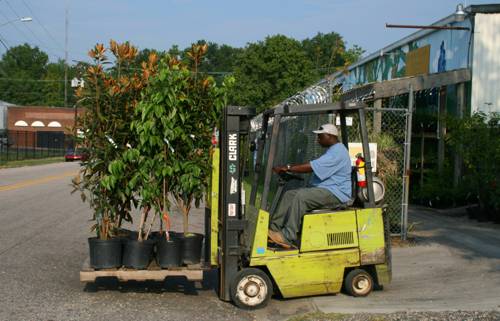
FAQ About Indoor Plant Transportation Methods

How should I prepare my indoor plants for transportation?
Before transporting indoor plants, make sure to water them a day before the move, not on moving day, to prevent excess water spillage. Clean the leaves from dust and check for pests, treating them if necessary. Remove any dead leaves or flowers, and prune the plants to reduce stress. Ensure the pots and plants are stable within their containers, using packing materials if needed.

Can I transport indoor plants in my car?
Yes, you can transport indoor plants in your car. It's best to place them in a stable position, preferably surrounded by boxes or soft materials to prevent tipping. Avoid direct sunlight on the plants, and keep the car at a moderate temperature to prevent stress and damage from temperature extremes.

What is the best way to transport tall indoor plants?
For tall indoor plants, consider wrapping them lightly in a breathable fabric, like an old sheet, to protect the leaves and stems. Lay them down gently in a car or moving van, ensuring they are well-padded and secured. Alternatively, if standing them upright, tie the plant lightly to stakes to stabilize it during transportation.

Should I prune my indoor plants before moving?
Pruning indoor plants before moving can be beneficial as it reduces the plant's size, making it easier to handle and less likely to suffer from stress. Remove any dead or damaged foliage and flowers to help the plant conserve energy during transportation.

How do I protect my indoor plants from temperature changes while moving?
To protect indoor plants from temperature changes during a move, plan your trip during mild weather if possible. Keep plants in an environment with stable temperatures such as the car cabin rather than a moving truck. Insulate the plants with blankets if transporting in colder conditions or use sunshades to keep out direct sunlight and heat.

Is it okay to transport plants in a moving truck?
Transporting plants in a moving truck can be challenging due to temperature extremes and lack of light. If necessary, make sure to secure them well to prevent tipping. Provide ventilation if possible and choose a position that minimizes exposure to direct sunlight and excessive heat or cold.

How do I pack small potted indoor plants for a move?
For small potted indoor plants, use boxes to hold several pots together, cushioning them with crumpled paper or bubble wrap to prevent them from moving. Make sure the box is labeled 'fragile' and as 'this side up' to ensure careful handling during the move.

What should I do if my plant gets damaged during transportation?
If a plant gets damaged during transportation, prune broken leaves and stems immediately to prevent disease and stress. Ensure the plant is watered appropriately and consider repotting if the soil or root system is disturbed. Give the plant time to recover in a well-lit and stable environment.

Can I ship indoor plants via mail or courier services?
Shipping indoor plants via mail or courier services is possible, but it requires careful preparation. Use sturdy boxes and pack the plant securely with cushioning to prevent movement. Consider using express shipping to minimize transit time and ensure the plant arrives quickly and in good condition. Be mindful of regulations regarding the shipment of plants across regional or international borders.

What are the common mistakes to avoid when transporting indoor plants?
Common mistakes when transporting indoor plants include not securing them properly, exposing them to extreme temperatures, over-watering before transport, and failing to check for pests. Always pack them carefully, avoid direct sunlight, and ensure they are placed in a stable and safe manner.

How can I ensure minimal stress to plants during relocation?
To ensure minimal stress to plants during relocation, maintain consistent care routines as much as possible, avoid over or under-watering before transport, and provide stable environments during the move. Upon arrival, allow the plants to adapt gradually to their new location.

What materials are useful for packing indoor plants for a move?
Useful materials for packing indoor plants include cardboard boxes, packing paper, bubble wrap, towels, and painter’s tape. Soft materials can cushion the plants, while boxes can provide structure and protection. Tape can secure packaging and cover pot tops to contain soil.

Is it necessary to acclimate indoor plants after moving them?
Yes, acclimating indoor plants after moving is essential. Place them in a suitable environment where they can gradually adjust to new light and humidity conditions. Monitor them closely for any signs of stress or necessary adjustments in care routines.

Can I use Uber or a taxi service to transport my indoor plants?
Using Uber or a taxi service to transport indoor plants is possible, but consider how much space your plants need first. Ensure the driver is comfortable with the arrangement, and safely position the plants to prevent spills or damage. Remember to protect the car interior from soil and moisture.

How can I transport my indoor plants if I'm moving long-distance?
If moving long-distance with indoor plants, plan to transport them inside the car where conditions are more stable. Alternatively, if using a relocation service, inquire if they can accommodate plants correctly. For very long-distance moves, shipping the plants via courier services designed for perishable items is worth considering.

Should I repot my plants before or after transportation?
It's generally better to repot plants after transportation to minimize stress, as repotting and moving both cause stress. Wait until the plants have acclimated to their new environment before repotting, unless the current pots are fragile or unsuitable for moving.

How do I secure plants in a moving vehicle?
Secure plants in a moving vehicle by placing them in boxes with cushioning materials like towels around the pots. Use seatbelts to secure larger pots, and stabilize pots within the vehicle to prevent tipping or movement. Ensure pots are grouped together and labeled fragile.

What should I do with large indoor plants during a move?
For large indoor plants, wrap them cautiously to protect leaves and branches. Transport them standing upwards if possible, supported by stakes if needed. Large plants may need multiple persons to carry and load gently onto the vehicle.

How do I prepare my plants for a temporary move or short trip?
For a temporary move or short trip, water the plants and ensure they are pest-free. Pack them in such a way that prevents tipping or soil disruption. Upon arrival, place them in a similar environment to where they were previously.

What are essential tips for moving indoor plants in winter?
When moving indoor plants in winter, do so mid-day when temperatures are warmer, and avoid leaving plants in a cold vehicle for long periods. Wrap pots and foliage carefully to insulate against the cold, and ensure they are moved quickly into a temperate environment upon arrival.
